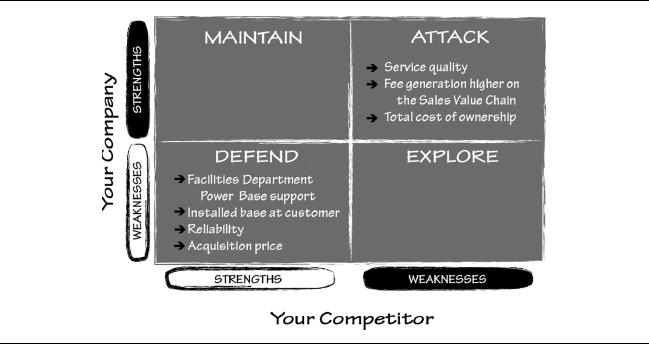Leveraging Politics, Unexpected Value, and Strategy to Shape the Customer’s Buying Criteria
Let’s say that you sell automatic teller machine (ATM) equipment and are attempting to win an opportunity at a commercial bank with multiple branches. The installed incumbent is your primary competitor. The bank is not totally unhappy with your competitor, but it has decided to bid it out due to concerns about service and a desire to test the market for lower prices. The bank’s Facilities Department was in charge of the bid and their request for proposal (RFP) stated the buying criteria as price, reliability/uptime, and service—the same criteria they used in a previous evaluation.
You quickly gather intel and conduct a preliminary Competitive Differentiation Analysis to see where you stand, as is shown in Figure 14.1.
Figure 14.1: Example of Your Competitive Differentiation Analysis

It is no surprise that your Defend box shows that you are not the installed incumbent and lack the support of the Facilities Department’s Power Base. You also recognize that your competitor’s equipment scores high in reliability/uptime, and it has a lower price. All in all, your competitor looks to offer a good solution—that is, on the surface.
But a different kind of picture emerges as you shift your attention to your Attack box. Your service quality is above industry standards. This is particularly important ...
Get The New Power Base Selling: Master The Politics, Create Unexpected Value and Higher Margins, and Outsmart the Competition now with the O’Reilly learning platform.
O’Reilly members experience books, live events, courses curated by job role, and more from O’Reilly and nearly 200 top publishers.

